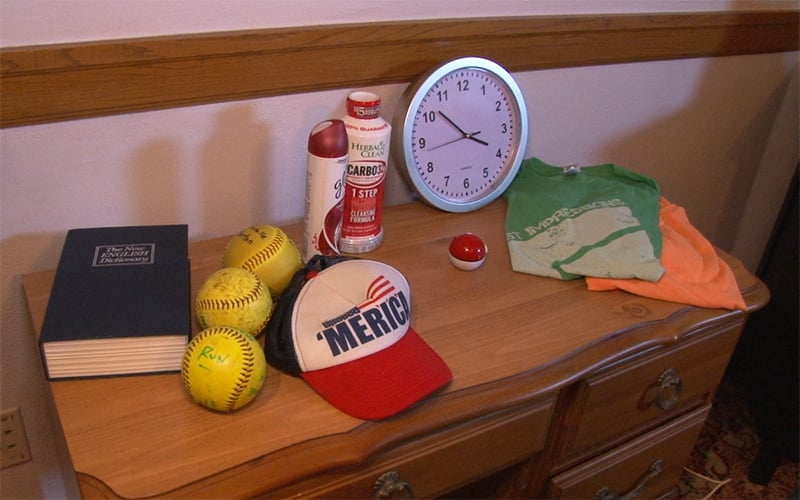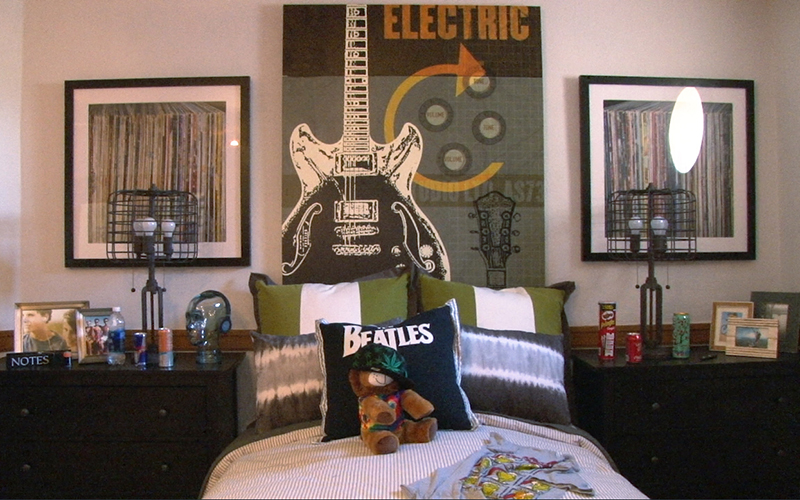PHOENIX – It seems like a normal room: There’s a can of hairspray by the mirror, a red trash can by the desk, an extension cord plugged into the wall and a teddy bear wearing a tie-dye shirt on the bed.
Unscrew the bottom of the can, and you’ll discover pills. Unfold the tinfoil in the trash, you’ll find black tar heroin. Open up the extension cord, you’ll see a “dab” rig – a kit to use marijuana. And the teddy bear? It’s got marijuana stuffed into its back.
Tell us what you think:
Are you concerned about opioid use in Arizona? | Cronkite News
Experts stashed all these items – and more – inside a mock teen bedroom to illustrate how easily teens can buy products online to hide their drug addiction.
It was part of a Monday tour created by the Arizona Governor’s Office of Youth, Faith and Family as part of their Addiction: The Elephant in the Room campaign to spread awareness about drug addiction and destigmatize it. It opened Monday on the fourth floor of the Arizona Capitol Museum, and participants can sign up to explore the room all week.
Hidden in Plain Sight is a tour for adults 21 years and older to walk through a staged bedroom set with 50 types of drug paraphernalia bought online.
The office’s Director Debbie Moak, who led the team that put this event together, said the tours aim to help parents identify the warning signs of drug use before it becomes an addiction.
Moak said today, teens have more access to drugs – many with a higher potency – than even a few years ago.
In 90 percent of all addictions, the user experimented with drugs before turning 18, she said.
“The earlier a teen experiments with drugs, the more likely they are to progress into full-blown addiction,” Moak said. “Primarily because of brain development, but certainly social, emotional development as well.”

The Hidden in Plain Sight tour contains drug paraphernalia bought online and stashed throughout the room, so participants can identify them and learn how they conceal drugs. (Photo by Andres Guerra Luz/Cronkite News)
Karen Mavrikos, a clinical therapist and behavioral health coordinator at Health Net Access, was a clinician from one of the five health organizations helping to give the tours this week.
She explained it’s “crucial” to prevent teen drug abuse because once the addiction takes hold of the brain, it causes the brain to perceive the drug as essential for survival.
“Rewiring that is an extremely intense battle,” Mavrikos said, and it can take years to do so.
She added that teenagers are more vulnerable to this rewiring because the brain doesn’t fully form until about 23 years old. So instead of developing “critical thinking, good values, good decision-making, self control and willpower,” teens delay that development and advance their dependency on drugs.
The average age Arizona youth are exposed to marijuana is 13.7, according to 2014 data by the Statistical Analysis Center’s Community Data Project.
The project, which combines data from various criminal justice agencies and Arizona Criminal Justice Commission’s Arizona Youth Survey, also shows that on average, 13 years old is the age when Arizona youth are exposed to methamphetamines, 12.9 is the age they are initiated to tobacco and 14.5 is when they first encounter regular alcohol use.
The good news: Those numbers have improved since 2008, with the exception of meth.
But Moak said any number of teenagers using and getting addicted to drugs is too much, and there are still dangers with early and prolonged use of drugs.
Youth under 15 years old who drink alcohol, she said, are five times more likely to become addicted to it.
“If you’re smoking marijuana, also in the teen years, one in six will go on to have a full-blown addiction. Five won’t,” Moak said. “But you simply don’t know if you are the one.”
Moak said there are two main factors that play into teenage drug use: accessibility and stress.
Moak said the drug paraphernalia stashed in the mock room were all items consumers could purchase on Amazon, and there is a big industry for these kinds of products so they aren’t too hard to find.
Another factor is stress, Moak said.
From facing school-related stresses like grades to dealing with social stresses like peer pressure, there are many teenagers who use drugs or consider using drugs to cope, Moak said.
“Too often, parents don’t understand the pressures their own kids are under today,” Moak said.
Parents need to encourage their children to talk about the stressors they’re dealing with, Moak said, and they should help them manage those issues.
“The research shows that actually parents are in the No. 1 position to influence whether their sons and daughters will use drugs or not use drugs,” Moak said.
Irene Rojas, one of the tour’s participants and a mother of two, said the event was “wonderful” and educates parents on the ways their teenagers can hide drugs.
“It’s scary,” Rojas said. Teenagers can access drug concealment items easily via the internet, she said, and those can arrive as soon as two days from purchasing.
“As long as you have a credit card, they don’t care how old you are,” she said.
